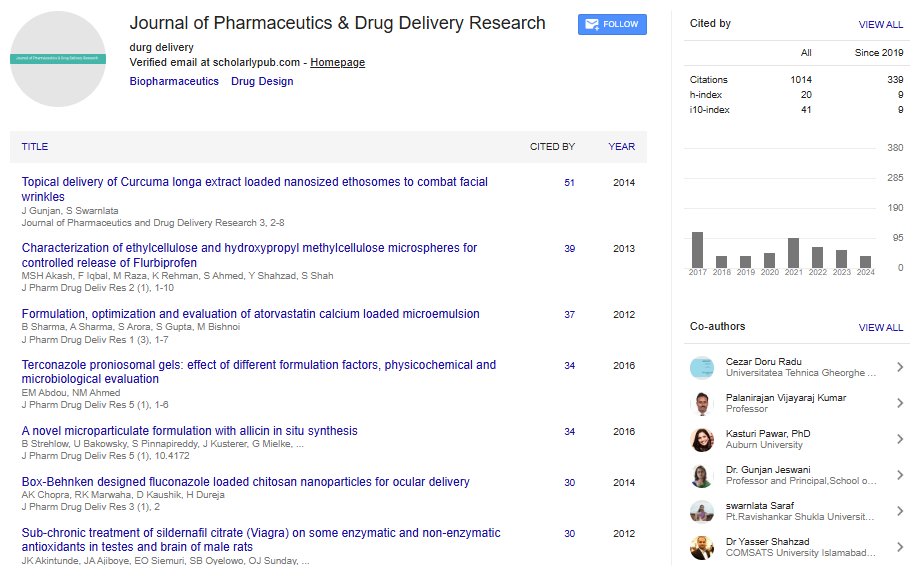Commentary, J Pharm Drug Deliv Res Vol: 13 Issue: 5
Drug Delivery System Developments: Revolutionizing Therapeutic Strategies for Precision Medicine
Chengwei Chen*
1Department of Pharmaceutical Sciences, San Diego State University, San Diego, USA
*Corresponding Author: Chengwei Chen,
Department of Pharmaceutical Sciences,
San Diego State University, San Diego, USA
E-mail: chenc48@gmail.com
Received date: 26 August, 2024, Manuscript No. JPDDR-24-151932;
Editor assigned date: 28 August, 2024, PreQC No. JPDDR-24-151932 (PQ);
Reviewed date: 11 September, 2024, QC No. JPDDR-24-151932;
Revised date: 18 September, 2024, Manuscript No. JPDDR-24-151932 (R);
Published date: 26 September, 2024, DOI: 10.4172/2325-9604.1000298
Citation: Chen C (2024) Drug Delivery System Developments: Revolutionizing Therapeutic Strategies for Precision Medicine. J Pharm Drug Deliv Res 13:5.
Description
Drug Delivery Systems (DDS) have significantly evolved, shifting from traditional dosage forms to sophisticated methods that provide targeted, controlled and efficient medication release. These systems are precarious in optimizing the therapeutic effects of drugs, minimizing side effects and enhancing patient compliance. From nanoparticles to biodegradable polymers, DDS has opened new frontiers in modern medicine, especially for diseases that require precision in dosage and target delivery.
At the core of any DDS are its components, which are carefully designed to suit the specific pharmacokinetics of the drug. The main goal is to ensure that the drug reaches the desired site of action at a controlled rate, allowing for sustained release over time. Advances in materials science have led to the development of various carriers, such as liposomes, micelles and dendrimers, which offer unique benefits in drug encapsulation, targeting and release.
Nanotechnology has transformed DDS by introducing nanoparticles that can cross biological barriers and deliver drugs precisely to the target site. Nanoparticles improve the bioavailability and stability of drugs, especially for poorly soluble or rapidly degrading compounds. These systems can be engineered to respond to specific triggers, such as pH changes or enzymes in the target environment, ensuring a more controlled and localized release.
Polymers, especially biodegradable ones, are widely used in DDS because they offer versatility and biocompatibility. Polymers like Poly Lactic-Co-Glycolic Acid (PLGA) are used to form microparticles and nanoparticles that degrade slowly, releasing the drug over time. These polymers can be tailored to provide either rapid or sustained drug release, making them useful for both acute and chronic treatments.
Liposomes and solid lipid nanoparticles are widely used in DDS because of their ability to encapsulate both hydrophilic and lipophilic drugs. Lipid-based carriers are also biocompatible and less toxic, making them suitable for delivering drugs directly to cells. Liposomal DDS has been successfully used in cancer therapy, where drugs are delivered selectively to tumor cells, minimizing damage to healthy tissue.
Hydrogels are three-dimensional polymeric networks that can absorb large amounts of water or biological fluids. They are beneficial for localized and controlled drug release, particularly in wound care and tissue engineering. Hydrogels can be loaded with drugs that release as the hydrogel gradually degrades, offering a long-lasting therapeutic effect.
In the context of precision medicine, DDS is indispensable. Precision medicine tailor’s treatment plans to individual patients based on genetic, environmental and lifestyle factors. DDS allows for a personalized approach, as drugs can be targeted to specific cells or tissues with minimal side effects. Examples include cancer therapies, where DDS targets tumor cells and gene therapies, where DDS delivers genetic material to correct cellular functions.
Cancer treatments often benefit from DDS because they can bypass the non-specific toxicity associated with chemotherapy. Targeted DDS in oncology can deliver drugs directly to tumor cells, sparing healthy cells. This targeted approach reduces side effects and improves the patient’s quality of life. Treating CNS disorders is challenging due to the blood-brain barrier, which restricts many drugs from reaching the brain. DDS, especially nanoparticles, can cross this barrier, allowing for the treatment of disorders like Alzheimer's and Parkinson's disease more effectively.
DDS has also enhanced the treatment of infectious diseases by improving the bioavailability of antiviral and antibacterial agents. Sustained-release DDS can help maintain effective drug levels in the body over extended periods, reducing the frequency of dosing and improving adherence to the treatment regimen.
Despite significant advancements, several challenges remain in DDS. One major challenge is the development of DDS that are affordable and scalable for large populations. Additionally, regulatory requirements for DDS are complex, as the systems must undergo rigorous testing to ensure safety and efficacy. Future research is focused on developing responsive and "smart" DDS that can adapt to environmental stimuli within the body to optimize drug release.
Conclusion
Drug delivery systems continue to revolutionize the field of medicine by providing innovative methods for administering drugs in a safe, effective and patient-centered manner. From nanoparticles to polymer-based systems, the advancements in DDS are flagging the technique for more precise and personalized treatments. As research progresses, DDS will likely become an integral component of precision medicine, further enhancing therapeutic outcomes and patient quality of life.
 Spanish
Spanish  Chinese
Chinese  Russian
Russian  German
German  French
French  Japanese
Japanese  Portuguese
Portuguese  Hindi
Hindi 
